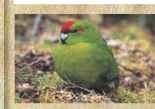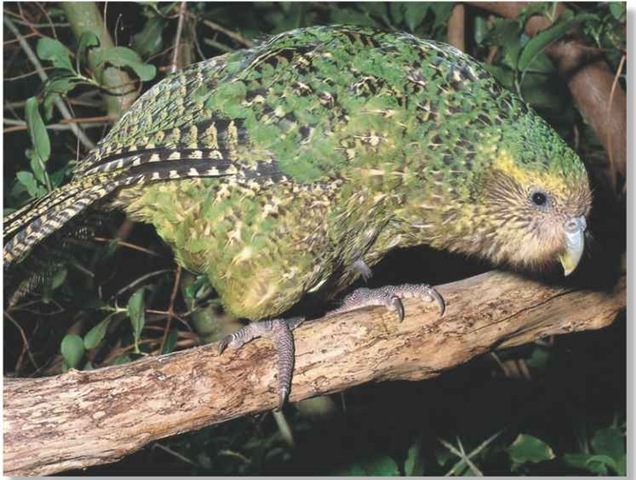ORDER
Psittaciformes
FAMILY
Psittacidae
GENUS & SPECIES
KEY FEATURES
• The world’s only flightless parrot and, at about 100 times the weight of a budgerigar, the heaviest
• Almost wiped out in its natural habitat by predators introduced by humans, it now survives on a few small islands under strict protection
• Unusual for a parrot, it’s almost always solitary
WHERE IN THE WORLD!
Native to New Zealand, but extinct across its former natural range on the mainland; introduced to three nearby islands: Little Barrier Island, Codfish Island and Maud Island
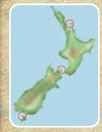
Lifecycle
Unable to fly, the kakapo relies on camouflage as its defense. Very vulnerable to predators introduced by humans, it’s now among the world’s rarest birds.
HABITAT
The kakapo was widespread in beech and podocarp (a dwarf conifer) forests of southern New Zealand, but Maoris and, later; European settlers, cleared 75% of this native vegetation. Settlers also introduced “alien” predators, including cats, stoats, weasels and dogs. Grazing animals, such as sheep, also drastically altered its habitat.
In the face of these threats, the kakapo declined until only a handful of birds were left. To ensure their future, these birds were captured and released into safe sites. Remaining birds now live only on a few small islands off the coast of New Zealand’s mainland islands.

A New island home Kakapo habitat on Little Barrier Island, New Zealand.
Green habits The kakapo is colored to blend in with its habitat.
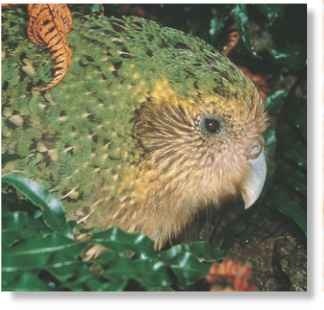
CONSERVATION
The species was abundant in the south and west of New Zealand’s South Island Until 1900; fewer than 60 kakapos now survive. In the 1970s and 1980s, the birds remaining on Stewart Island (a stronghold off the south coast of South Island) were moved to remote islands where all introduced predators were exterminated. Relocated populations require supplementary feeding; these islands support few trees that produce the high-protein fruits needed for successful breeding.
An old English name for the kakapo is “owl parrot,” a reference to its owl-like face and nocturnal habits.
Unlike many species of parrot, it has so far proved impossible to create the right conditions to keep and breed kakapos in captivity. The species can only survive in the wild.
Unusual for a bird, the kakapo has a strong and distinctive smell and may scent-mark its surroundings like a mammal.
BEHAVIOR
Unlike other parrots, the kakapo is solitary — except in the breeding season. Each bird occupies a territory of about 0.2 sq. mile, spending the day under shrubs, in burrows under tree-roots or in rock crevices. At dusk, the almost entirely nocturnal kakapo feeds.
The kakapo can’t fly, but is an agile climber, using its feet and bill while balancing with outspread wings. It moves with surprising speed downhill by running with a clumsy gait and gliding for short distances. When kakapos move to higher ground to feed or breed, they tend to follow the same routes; over the years, their movements wear away tracks through the undergrowth.
FOOD & FEEDING
Strictly vegetarian, the kakapo feeds on a variety of fruits, seeds, shoots, leaves, roots, moss, fungi and tubers. It searches for food on the ground, climbs into the lower branches of shrubs and trees or digs up roots and tubers with its sturdy bill. With an action similar to that of a pair of gardening shears, the bill can slice through tough stems.
Kakapos chew food with their bill, unlike the great majority of birds, which use a muscular part of the stomach, called the gizzard, to grind their food. The kakapo’s bill, though, is equipped with a series of ridges on the inside of the upper mandible. These work against the tongue and lower mandible to shred tough, fibrous food.
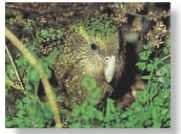
Loner
Most parrots are sociable, but not the kakapo.
Undercover
During the day, kakapos rest under rocks, roots or shrubs.

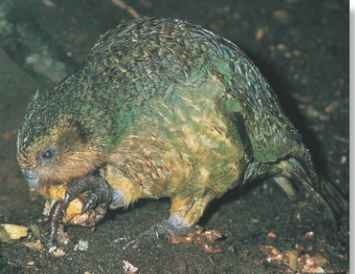
A Feet first
The kakapo often grasps large or tough food items with one of its feet.
BREEDING
The kakapo doesn’t breed every year; its normal diet is too poor in nutrients. High-protein seeds and fruit are needed before males can perform energetic courtship rituals and females come into breeding condition. Good crops are produced only every few years, and the kakapo is restricted to breeding at these times.
When breeding, males share a network of tracks leading to shallow “bowls” in the ground, set on prominent ridges, forming a group courtship arena, or lek. Each male occupies his own bowl and “booms” continuously for 6-8 hours every night from December to March. Females travel several miles to visit the lek, choose a male and mate.
A female builds a nest, incubates the eggs and raises the offspring by herself. They fledge at around 10-12 weeks.
BIG BOOMER
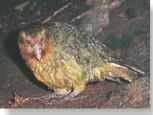
A Sound system
A male’s shallow “bowl” amplifies his loud calls in the breeding season.
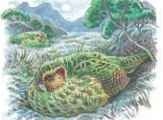
Boom in the gloom…
Males gather at a traditional courtship arena at night. Sitting in their bowls, they boom loudly, as if blowing over the top of bottles.
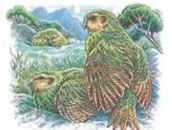
Dancing partner…
Rival males try to get the females’ attention by performing a dancing display. Most females mate with dominant males.
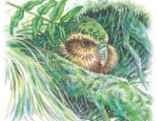
Sitting it out..
The female builds a simple nest and incubates her 2-3 white eggs. She receives no help from the male in these tasks…
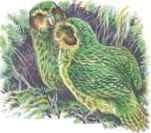
Single parent
…and for the first 4 weeks, broods the chicks all day, feeding them by night. By 8 weeks, she visits only once or twice a night.
PROFILE
Kakapo
As large as a domestic cat and flightless, the kakapo is an owl-like parrot that is adapted to earn a living on the ground, under cover of the night.
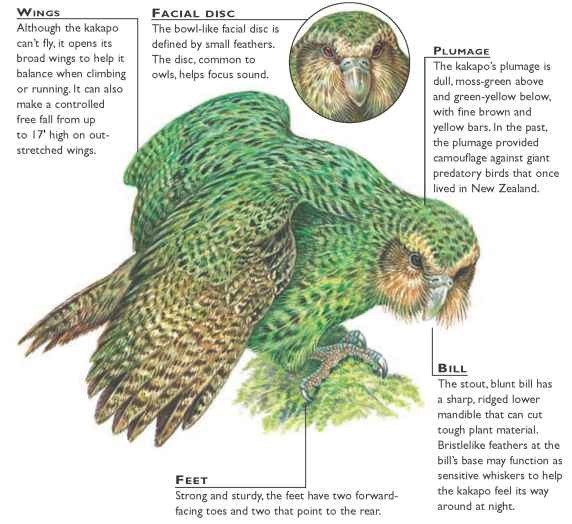
CREATURE COMPARISONS
The kakapo resembles another large parrot native to New Zealand: the kea (Nestor notabilis). But the kea is a powerful and agile flier; its bill is much larger than the kakapo’s and is strongly hooked with a long, sharply pointed upper mandible. The kea isn’t exclusively vegetarian; it uses its bill to dig up burrowing invertebrates and as a meat hook to tear into carrion — especially sheep carcasses.
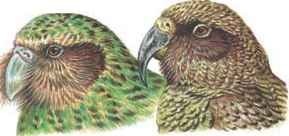
Kakapo
Kea
| VITAL | |
| STATISTICS | |
| Weight | Male 5.5 lbs.; female 4 lbs. |
| Length | 2′ |
| Sexual Maturity | 6-8 years |
| Breeding Season Number of Eggs |
December i -May |
| 2-4 | |
| Incubation Period | 30 days |
| Fledging Period | 10-12 weeks |
| ‘Breeding Interval | 3-5 years; “relocated” birds breed more frequently |
| Typical Diet | Fruits, seeds, leaves, stems and roots |
| Lifespan | At least 20 |
| years; some reach 30-40 | |
RELATED SPECIES
• The kakapo’s closest relatives are probably the ground parrot and the little-known night parrot of Australia. There are six parrot species native to New Zealand. The red-crowned parakeet (below) is the only one to occur elsewhere: on Norfolk Island and New Caledonia.
